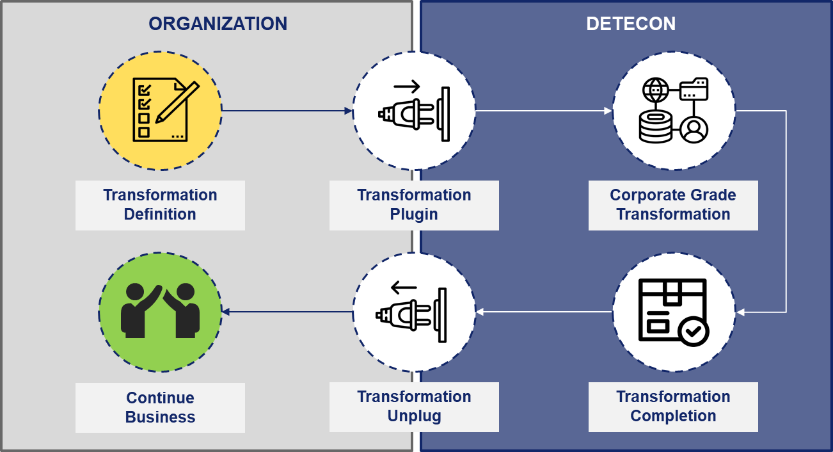There is hardly anything that does not exist "as a service" in the digital age. Software as a Service, Platform as a Service, Instrastructure as a Service - just to name the most prominent examples. Now transformation projects can also be purchased as a service. Roland Fadrany explains what transformation as a service is all about.
Transformation comes from the Latin term transformare and means to transform. In the context of business transformations, the term is therefore used to describe a change process that brings companies from a current as-is to a future target state. Always with the goal of emerging from the transformation more competitive and successful. In today's world, in which industrial boundaries are blurring, previously known value-adding structures are changing, the half-life of competencies has already fallen drastically (1980: 30 years, today: 5 years), and companies can no longer operate their core business with their usual profitability, the topic of transformation is becoming increasingly important.
In the Business Technology chapter of Detecon International we have defined the term transformation with the help of five core elements:
- Technological change: Transformation is caused by technological change, such as the increased use of cloud solutions in companies.
Temporary: The transformation has a clearly defined start and end time.
Rollout character: It is a transformation with rollout character. A good example of this is the following: a company must switch from fixed workstations to remote work. Among other things, a hardware rollout is necessary for this.
Repetitive: The transformation must also be defined by repetitive or recurring tasks. To come back to the example: The hardware must not only be procured once, but made available to all employees.
Process/Culture: The transformation changes processes in the company, which in turn can also have an impact on the corporate culture.
Thinking transformation bigger - as a service
The basic idea of Transformation as a Service (TaaS) is to perform transformations for our customers. This enables our customers to continue to concentrate on their core business. In addition, only low set-up costs for personnel and knowledge build-up arise on the customer side.
After we have precisely defined the transformation project together with the customer, the next step is to detach the transformation from the customer organization and connect it to our team of transformation experts (plug-in).
Using state-of-the-art tools and methods, such as software-based automation of individual process steps or automated documentation of transformation processes, we carry out the transformation for our customers and keep them up to date with regular status reports. Through the targeted implementation of software robots, for example, we have been able to reduce the processing time of particularly complex process steps of a transformation project many times over. Coupled with partially automated workflows, documentation systems and reporting, the path to successful change is further smoothed. Especially the temporary and often time sensitive character requires a trained view on processes, data and applications to evaluate the use of the optimal "tool engine".
Once the transformation goal is achieved, we ensure a smooth transition to Business-as-usual (unplug) with final project reports.

Step by step along the transformation cycle
Step by step along the transformation cycle TaaS as an offering includes both strategic and operational components. Along the transformation cycle, we have defined 8 phases that a company must go through in a transformation.
The first part of the Transformation Cycle contains four planning phases:
- Assessment of the current situation
- Potential & Risk Analysis
- Solution Design
- Rollout Planning
At this point, we work together with the customer on strategy and concept. On the one hand, the actual situation as well as possible chances and risks have to be described exactly. On the other hand, the target design of the transformation must be clearly defined and the rollout must be planned accordingly.
The second part of the Transformation Cycle includes four operational phases:
- Governance
- Implementation
- Automation & Optimization
- Handover to Operations
In these phases we are operationally working for the customer and implement his transformation with the help of the most modern tools & methods. In the end, the focus is on the handover to the customer, with which we ensure a seamless transition to business-as-usual.
Change on demand
Unique selling point of the offering is the "plugin and unplug principle". In contrast to conventional transformation offerings, we not only provide support in a strategic and advisory form, but also act operatively for the customer. This means that the customer plans and defines his transformation project together with us, we carry out the transformation for the customer (Plugin) and after completion he can continue his daily business without interruption (Unplug).
The biggest customer advantage is on the one hand the reduced organizational set-up costs for knowledge or personnel development, on the other hand the possibility to continue to concentrate on the core business. True to the motto: Everyone does what he does best.
TaaS is suitable for all industries and/or customers. As long as the transformation character shows the characteristics we have defined, the modular approach can be applied customer-/project-specifically.







